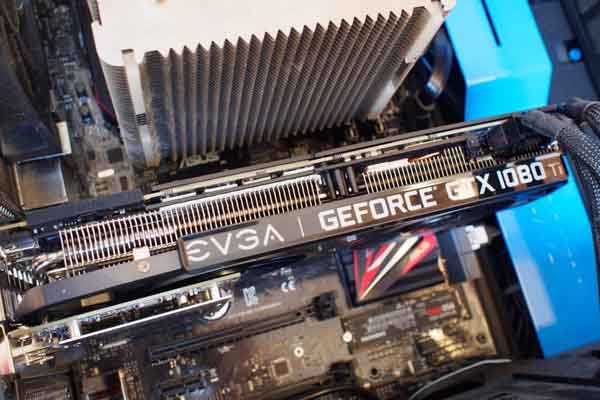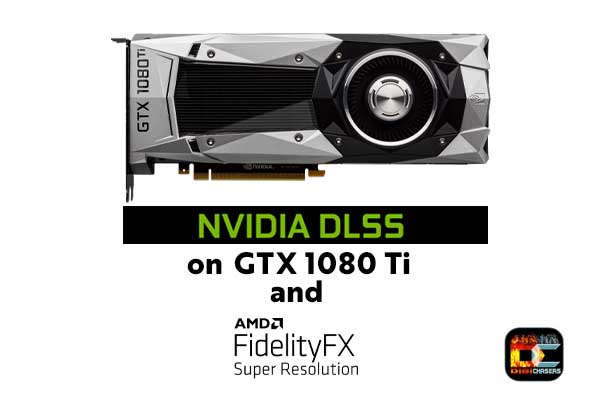Many of you have already heard of DLSS, but do you know what it is? The most important question is which video cards are supported by DLLSS? Does the 1080ti support DLSS?
GeForce GTX 1080ti today

Nvidia released GTX 1080ti in March 2017. From that day, two generations of GPU has been changed. Although the unforgettable fact that the GTX 1080ti at its release time was a top-tier GPU, even now, video card outperforms such video cards like RTX 2070, RTX 3060 and can be compared to RTX 2080 or RTX 3070.
GeForce GTX 1080ti has an 11 GB of VRAM, which is very big for even today, for the fact, RTX 3060 has 12 GB VRAM, but in many cases has worse performance. However, if you are not playing a ray tracing game, then the GTX 1080ti will always be a winner compared to the RTX 3060.
What is DLSS?

DLSS stands for deep learning super sampling, and from June 2021, the technology is available on GeForce RTX 20 and GeForce RTX 30 series GPUs. In traditional words – super sampling is a technique where you have a game running at a higher internal resolution than what’s displayed on your monitor. This is most commonly used as anti-aliasing to help remove jagged edges. So your monitor might only be 1080p; the game could be running in 4K. Gamers use this to create crisp, sharper looking image quality, but it requires beefy hardware.
So does DLSS works on GTX 1080 ti or not?
Nvidia claims that DLSS is only for GeForce RTX20 and GeForce RTX 30 series GPUs. DLSS on GeForce GTX 1080ti is possible, but performance would be TERRIBLE. 1080ti can run DLSS by software, but it does not require hardware.
DLSS requires special hardware, and it only works on Turing tensor architecture cores.
Pascal cores and Turing tensor Cores
The GeForce GTX 1080 Ti is based on the NVIDIA Pascal cores architecture. And the new generation RTX cards have tensor cores, which can work with DLSS.
Nvidia’s RTX video cards that have ai-based tensor cores DLSS takes a target resolution and displays an image of that quality while using a lower base resolution.
That means if you can run games at 1440p, but starts to struggle when displaying at 4k, and you have a 4k monitor, using DLSS 1440p games will be reconstructed in real time to 4k at less computational cost.
Maybe DLSS doesn’t work on GTX 1080 ti, but AMD has developed an equivalent to DLSS, called FidelityFX Super Resolution (FSR).
Nvidia DLSS vs AMD FSR

Nvidia DLSS and AMD FSR are two similar sampling technologies, but as we know, DLSS works only on RTX generation GPU. DLSS was released in February 2019 and AMD FSR in June 2021.
FSR – fidelityFX super-resolution is a different beast compared to DLSS. When AMD created FSR, they set a goal to be an open-source upscaling solution based on industry standards, which does not require any specialized hardware. For example, DLSS works only on GPU’s which are Tensor cores.
However, those two rendering techniques are similar but work differently. FSR works by partial upscaling using only the source image; DLSS supplies the neural network through several inputs: the source image, the motion vector, the temporary feedback from previous frames, and the results of its training algorithm.
From our perspective, DLSS has improved anti-aliasing, image quality and handling of subpixel details compared to FSR. AMD FSR is easier to adapt to different GPUs and has less anomalous artifacting than DLSS.
AMD FSR on GTX 1080 ti?
Yes, it is supported on GTX 1080 ti, and on many other older GPU models.
GPU list that can support FSR
- AMD Radeon 6000 Series
- AMD Radeon 6000M Series
- AMD Radeon 5000 Series
- AMD Radeon 5000M Series
- AMD Radeon VII
- AMD Radeon RX Vega Series
- AMD Radeon 600 Series
- AMD Radeon RX 500 Series
- AMD Radeon RX 480, 470 and 460
- AMD Ryzen desktop CPUs with AMD Radeon graphics
- AMD Ryzen mobile CPUs with Radeon Graphics
- Nvidia GeForce RTX 30 Series
- Nvidia GeForce RTX 20 Series
- Nvidia GeForce 16 Series
- Nvidia GeForce 10 Series (GTX 1080 ti as well)
Example of FSR performance
AMD FSR can show fascinating results on GTX 1080 ti, by upgrading FPS results from 93 avg FPS to 120 avg FPS on Resident Evil 8.
Although FSR is still a fresh thing, games with this option can be found.
Games with FidelityFX Super Resolution (FSR)
- World of Warcraft: Shadowlands
- 22 Racing Series
- Anno 1800
- Arcadegeddon
- Back 4 Blood
- Baldur’s Gate III
- Black Desert Online
- Chernobylite
- Deathloop
- Dota 2
- Edge Of Eternity
- Elite Dangerous
- Enlisted
- Evil Genius 2: World Domination
- F1 2021
- Far Cry 6
- Gamedec
- Godfall
- Kingshunt
- Marvel’s Avengers
- The Medium
- Myst
- Necromunda: Hired Gun
- The Riftbreaker
- Resident Evil Village
- Terminator: Resistance
- Vampire: The Masquerade – Bloodhunt
- World War Z Aftermath
Games with unofficial FSR
As you can see, the list of games is not small. Have you tried some games with the GTX 1080ti with the FSR option enabled? Write a comment about what the change in FPS was.
Video example where you can see the difference between enabling and disabling AMD FSR.
Author Recommended Reads:
- How to Undervolt Your CPU & GPU – Complete Guide (Safe)
- Is 75Hz Good for Gaming – Gamer Opinion
- Most Expensive Video Card
- What Resolution is 3840×1080? Explained.
If you have more questions, please ask them in the comments section. We hope that this article was helpful to you.



This is WRONG: “super sampling is a technique where you have a game running at a higher internal resolution than what’s displayed on your monitor. This is most commonly used as anti-aliasing to help remove jagged edges. So your monitor might only be 1080p; the game could be running in 4K.”
And you even contradict it later, with the correct explanation of what DLSS actually does: “That means if you can run games at 1440p, but starts to struggle when displaying at 4k, and you have a 4k monitor, using DLSS 1440p games will be reconstructed in real time to 4k at less computational cost.”
In short — DLSS takes a lower resolution image and uses AI to turn it into a higher resolution image. Therefore you can run the game at a lower internal resolution, but have higher resolution visual output. Upscaling with this technique is not perfect (there are occasional artifacts, and sometimes it has the appearance of film grain), but its benefit is that the computational cost of doing this is less than the cost of actually running the games in higher resolution. As a result, you can get higher frames per second and have visuals that are similar looking to running the game in higher resolution.
To get an idea of the computational cost jump from 1440p to 4k, 1440p resolution has about 3.7 mega pixels in an image (3686400 pixels), and 4k has 8.3 mega pixels (8294400 pixels). Therefore when running the game at 4k resolution, the hardware has to figure out the color & brightness value of more than two times the number of pixels, making it just about 2x more difficult.
With DLSS the game can be run at 1440p, and to produce a 4k image the DLSS software is filling in the missing pixels in the larger image by extrapolating techniques, using AI and other methods. This extrapolation is less computationally intensive than actually figuring out the values for the pixels through the game’s engine, reducing the overall computational load and allowing for higher frames per second output.
Thanks for your reply, I will analyze your given information and edit Article if I was wrong.
I really appreciate your comment. 🙂 Have a nice day. 😉
I appreciate your response. Upon re-reading, maybe “misleading” is more appropriate, rather than wrong.
What you have is correct about “super sampling”, *in the context of anti-aliasing*.
However, in the context of upscaling resolutions, super sampling techniques are used for a different purpose. Considering the previous sentence starts with “DLSS stands for deep learning super sampling”, it’s confusing to go into the anti-aliasing explanation, because it is almost the opposite of what DLSS is used for.
I am very grateful for the correction. Maybe there is a way to refer to your information in the footnote?